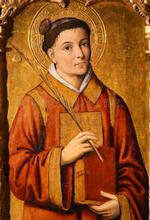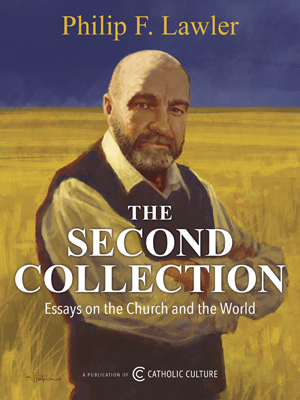The Splendor of the Liturgical Year
By Fr. Jerry Pokorsky ( bio - articles - email ) | Jul 28, 2025
Among the most rewarding experiences for a priest paradoxically comes within the midst of great family sorrow. A family member calls a priest to visit an unconscious person slipping into eternity. The priest recites the prayers and concludes with the Our Father. But the lips of the dying person vaguely coincide with the Lord’s Prayer. Jesus is accompanying the person across the threshold to eternal life.
The Our Father precedes Holy Communion at every Mass. We hallow the Divine name. We pray for our daily bread. We ask for forgiveness and the courage to forgive. We beg God to deliver us from evil. The Our Father is the perfect prayer, and the Church liturgically reinforces its perfection with the reception of Holy Communion.
The liturgical year is crucial for Christian formation. The annual liturgical cycle guarantees every generation hears the central and enduring truths of our salvation. The greatest celebrities of our generation are passing away. Ask any Catholic youngster today: Do you know who Frank Sinatra was? You don’t! We’re losing our heritage! Celebrity idols come and go. But the kids know the Our Father, don’t they?
The liturgical year begins in the darkness of December as we prepare for the birth of Jesus. During Advent, the priest wears the regal violet vestments of repentance and preparation. Scriptural readings remind us of prophecies on the verge of fulfillment. December 25 sees the birth of Jesus, and we celebrate the epiphanies, or manifestations, of the Incarnation. The liturgical cycle reminds us that the Incarnation took place nine months earlier in secret, on March 25, the Feast of the Annunciation, when Mary said to the Angel Gabriel: “Behold the handmaid of the Lord and be it done unto me according to thy word.” And the Word was made flesh and dwelt among us. (Life begins at conception. Christians who follow Mary in faith also follow the science.)
The peace of the Christmas season continues with the priest and altar adorned with festive garments and decorations. The season concludes, according to the new calendar, with the Baptism of the Lord. The Baptism of Jesus and the descent of the Holy Spirit upon Jesus in the form of a dove launch his public ministry in January.
The season of Ordinary Time continues with His first miracle, the wedding feast at Cana. The words and mighty deeds of Jesus in the ensuing weeks set the stage for Ash Wednesday and the forty days of Lent. The events of Lent fulfill Old Testament prophecies. Jesus is the Prophet Isaiah’s Suffering Servant. Jesus’ confrontations with His enemies lead to the violence of Palm Sunday and the drama of Holy Week.
The three days of the Triduum reenact the central truths of the Catholic faith. Holy Thursday sees the institution of the priesthood and the Eucharist. The Good Friday Cross reveals the horror of our sins. And Jesus overcomes sin, suffering, and death on Easter, His glorious Resurrection.
The Easter season during Spring continues with accounts of the appearances of the resurrected Jesus in His glorified body. We revisit significant Gospel scenes—such as the miraculous multiplication of the loaves—in the light of the Resurrection. The feast of the Ascension celebrates the victorious return of Jesus to His heavenly Father. Pentecost completes the revelation of the Blessed Trinity, God is Three-in-One, the first mystery of our faith. The red vestments remind us of the fiery red tongues descending on Mary and the disciples. The feasts of the Holy Trinity and Corpus Christi reintroduce Ordinary Time.
Summer is the season of growth, and the green vestments of Ordinary Time remind us that our faith, like field grass, imperceptibly grows with our devotion. We celebrate special holy days of obligation throughout the liturgical year, such as the August 15 Feast of the Assumption, when Mary is assumed, body and soul, into heaven.
The days of Fall remind us that our lives will come to an end, fulfilling the melancholy of Psalm 90: “Our life is over like a sigh. Our span is seventy years or eighty for those who are strong. And most of these are emptiness and pain.” So we rejoice with the anonymous saints on All Saints Day and pray for the repose of the souls of the faithful departed on All Souls Day.
The liturgical year comes to an end in late November with the Feast of Christ the King. Our life is not futile because Christ rules now and forever. Jesus desires us to join Him on the Cross, assuring us that we who suffer with Him will rise with Him.
Years ago, I took an elderly man who was tending his dying wife to the hospital café for a much-needed cup of coffee. During WWII, he was a member of the Dutch resistance. Late in the war, he saw the German V-1 rockets in the sky with London as their destination. One of the rockets sputtered out of control within his sight, crashed, and destroyed an empty Catholic orphanage. The only remaining structure was a statue of Christ the King with arms outstretched. With a twinkle in his eye, he affirmed his faith in a loving God amidst every trial—despite his many trials: “Christ rules!”
The rituals of popular music and entertainment compete with the sacred liturgy. But future generations will not remember the many tunes such as “My kind of town, Chicago is” and “Lucy in the sky with diamonds.” Even today, the cultural cliches of my generation dumbfound the kids. But not the Our Father for the many who attend Mass.
Do you want to lead the way to heaven with your kids and grandkids following our example in Jesus? Don’t miss Sunday Mass. The liturgical year, with God’s grace, reinforces the saving prayer of the Our Father and reconciles us with the saving mysteries of Christ. Heaven and earth will pass away, but the liturgy in this life guarantees the words of Jesus will never pass away.
All comments are moderated. To lighten our editing burden, only current donors are allowed to Sound Off. If you are a current donor, log in to see the comment form; otherwise please support our work, and Sound Off!








